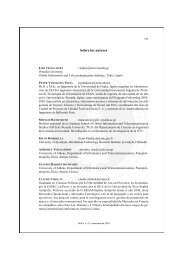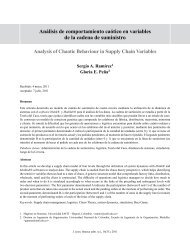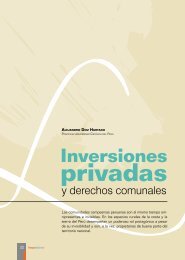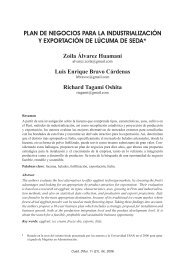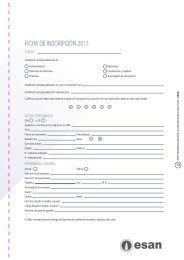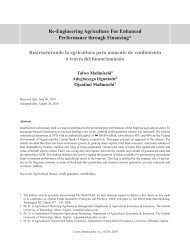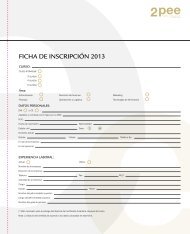Hofstede's Cultural Dimensions and Tourist Behaviors: A ... - Esan
Hofstede's Cultural Dimensions and Tourist Behaviors: A ... - Esan
Hofstede's Cultural Dimensions and Tourist Behaviors: A ... - Esan
You also want an ePaper? Increase the reach of your titles
YUMPU automatically turns print PDFs into web optimized ePapers that Google loves.
40 Journal of Economics, Finance <strong>and</strong> Administrative ScienceDecember 2011These results provide some very interesting insightson tourist behavior in terms of the expectations ofdesirable behavior <strong>and</strong> perceptions of actual behaviorby tourists themselves <strong>and</strong> by service providers. First,the comparison of the opinions/ratings of the twogroups (tourists themselves <strong>and</strong> service providers)on expectations of the desirable tourist behavior (C1)showed only 1 out of 23 divergent results. This impliesthat there was a fair amount of agreement between thetwo groups as to what is considered as the desirabletourist behavior. Korean tourists constitute a sizeablepercentage of inbound tourists in Australia <strong>and</strong> thisfinding conveys that Australian service providers haverelatively good idea of the expected code of conductbased on the cultural norms of the tourists’ culture oforigin (Korean culture). Second, the comparison ofactual versus desirable tourist behaviors, namely C3<strong>and</strong> C4, showed that both groups gave opinions/ratingsthat indicated a deviant actual behavior comparedto the desirable behavior based on cultural norms oftourists. For C3, comparing the differences withingroup (actual versus desirable tourist behavior ratedby tourists themselves), 22 out of 23 comparisonswere statistically significant. For C4, comparing thedifferences within the group (actual versus desirabletourist behaviors rated by service providers), all 23comparisons were statistically significant. This findingsuggests that Korean tourists on group tours behavequite differently compared to their cultural norms <strong>and</strong>this view is shared by both tourists <strong>and</strong> the serviceproviders.Package tourism is extensively used in China,Japan, <strong>and</strong> Korea. These are collectivistic societieswhich encourage, <strong>and</strong> often require, adherence to socialnorms <strong>and</strong> accepted patterns of collectivistic behaviors,geared towards the larger interests of the society ratherthan the individuals. These group-oriented societiesare also extremely hierarchical <strong>and</strong> respect authority.Tourism planning <strong>and</strong> execution of all the arrangementsrequire careful attention to details as well as personal,social, financial, <strong>and</strong> safety risks. Package tourismoffers a structured mode of travel, minimizes the risk<strong>and</strong> uncertainty, <strong>and</strong> provides a platform for collectivesocial interaction.However, typically collectivistic, high power distancesocieties are also extremely competitive <strong>and</strong> theindividuals feel a need to escape from their stressfulroutine life (Han & Heather, 2001). Therefore, manyindividuals seek novelty through pleasure travel to internationaldestinations. While these tourists may join apackage because of advantage of collectivity, structure<strong>and</strong> risk reduction, their motivation for pleasure travelto an international destination is often driven by adventure<strong>and</strong> novelty seeking. Consequently, the behaviorof these tourists on package tours would deviate fromthe norms of their home culture.The authors bring in the concept of “<strong>Tourist</strong> Culture”(Jafari, 1987) in addition to the “National Culture” toexplain their findings in this study. The “National Culture”is captured through five dimensions of Hofstede(1980, 2001). The authors postulate that the touristbehavior in group tours is a function of national cultureof the tourists <strong>and</strong> the temporary tourist culture, whichthe individuals may adopt when on a holiday. Accordingto Jafari (1987), tourist culture “…defines <strong>and</strong>redefines roles, rules, notions, motions, forms, forces,expectations, processes, <strong>and</strong> the nature of animation”(153). The authors further quote Jafari (1987) on thetransformation of the tourist “…as the emergence intotouristhood deepens, the tourist … is transformed intoa new person with a new identity (the tourist) that heis playing on a new stage (the magnet) <strong>and</strong> thus he isliving up to the magnet of a new culture (the “touristculture”)” (157). The quest for unusual, out of theordinary experiences, which would not be normallypermitted back home, leads many tourists to embrace“tourist culture” behaviors. Jafari <strong>and</strong> Way (1994) suggestthat for international tourists, an escape from thenorms of their home culture may in fact provide themwith relief from their ordinary <strong>and</strong> routine life, <strong>and</strong>provide tourists with relaxation <strong>and</strong> novelty.The findings of Kim <strong>and</strong> McKercher (2011) suggestthat Korean tourists tend to deviate from their homecultural norms while taking package tours in Australia.They tend to be noisier, rearrange restaurant layouts, eat<strong>and</strong> drink in their rooms <strong>and</strong> engage in more extremecollectivistic behaviors. At the same time, they are lessJ. econ. finance adm. sci., 16(31), 2011



